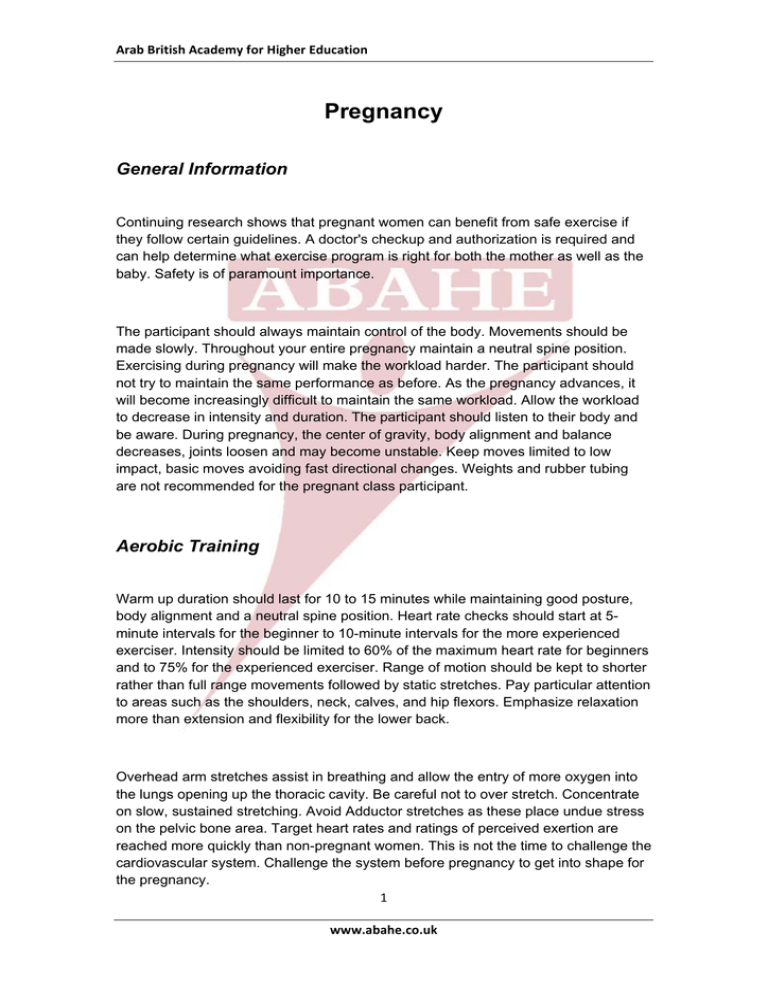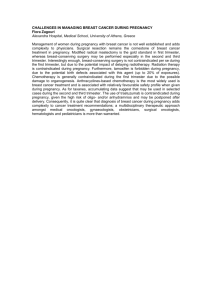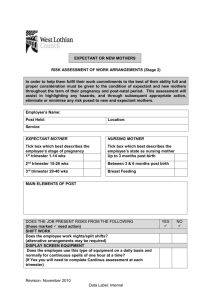
Arab British Academy for Higher Education Pregnancy
General Information
Continuing research shows that pregnant women can benefit from safe exercise if
they follow certain guidelines. A doctor's checkup and authorization is required and
can help determine what exercise program is right for both the mother as well as the
baby. Safety is of paramount importance.
The participant should always maintain control of the body. Movements should be
made slowly. Throughout your entire pregnancy maintain a neutral spine position.
Exercising during pregnancy will make the workload harder. The participant should
not try to maintain the same performance as before. As the pregnancy advances, it
will become increasingly difficult to maintain the same workload. Allow the workload
to decrease in intensity and duration. The participant should listen to their body and
be aware. During pregnancy, the center of gravity, body alignment and balance
decreases, joints loosen and may become unstable. Keep moves limited to low
impact, basic moves avoiding fast directional changes. Weights and rubber tubing
are not recommended for the pregnant class participant.
Aerobic Training
Warm up duration should last for 10 to 15 minutes while maintaining good posture,
body alignment and a neutral spine position. Heart rate checks should start at 5minute intervals for the beginner to 10-minute intervals for the more experienced
exerciser. Intensity should be limited to 60% of the maximum heart rate for beginners
and to 75% for the experienced exerciser. Range of motion should be kept to shorter
rather than full range movements followed by static stretches. Pay particular attention
to areas such as the shoulders, neck, calves, and hip flexors. Emphasize relaxation
more than extension and flexibility for the lower back.
Overhead arm stretches assist in breathing and allow the entry of more oxygen into
the lungs opening up the thoracic cavity. Be careful not to over stretch. Concentrate
on slow, sustained stretching. Avoid Adductor stretches as these place undue stress
on the pelvic bone area. Target heart rates and ratings of perceived exertion are
reached more quickly than non-pregnant women. This is not the time to challenge the
cardiovascular system. Challenge the system before pregnancy to get into shape for
the pregnancy.
1 www.abahe.co.uk Arab British Academy for Higher Education Weight Training
Abdominal work after the first trimester remains controversial and is not
recommended. Train the muscles before pregnancy to help with the pushing stage of
labor. The elastic memory of strong abdominal muscles will help speed up your
return to the pre-pregnant condition. Upper back exercises will counter the stooping
effect of heavier breasts. It is important to remember that during pregnancy is not the
time to get into shape. The goal should be to simply stay in shape. Before the
pregnancy is when conditioning and strength training should be accomplished. It like
training for an event, you wouldn't wait until the race to begin training.
Trimester Specific
During the first trimester, women can usually perform the same abdominal exercises
as non-pregnant exercisers. A supine position (lying on the back) is considered safe.
It's still best to check with your doctor because understandings change due to
ongoing research. In all cases, use common sense and listen to your body.
During second and third trimesters, it is best to limit abdominal work to less than five
minutes. Women in the later stages should rest sitting up or lying on their left side for
a few minutes while other class members complete abdominal work. Again, your
doctor should issue the guidelines during all phases of pregnancy. Overall, the best
exercise for the pregnant exerciser is walking.
Exercises
Pelvic Tilt (first trimester only):
Start on the hands and knees.
Head in alignment with the spine.
Back straight.
Contract the abdominals and point the tailbone to the floor.
Hold for a count of three and release.
Relieves low backaches and strengthens the abdominals by maintaining
proper alignment of the pelvis.
Crunches (up to second trimester):
2 www.abahe.co.uk Arab British Academy for Higher Education
Crunches with a pillow support (shoulders elevated above the heart).
Let-Backs (up to second trimester):
Sit with knees bent and hands around the knees for support
Contract the abdominals and curl the spine while leaning back as far as the
arms will allow.
Alternate with oblique curls using pillow support.
C-Curves (up to third trimester):
Kneel on the floor on all fours or with elbows on a chair seat for support.
Inhale and contract the abdominals while creating a "C" shape with the spine.
Exhale and release.
Side C-Curves (up to third trimester):
Lie on the left side with the upper hand on the floor for support.
Contract the abdominals and bring the knees to the chest.
Exhale and release.
Nutrition
In addition to your doctor's recommendations:
Eat a small, easily digestible snack (such as crackers) prior to exercise.
Drink plenty of water before, during and after exercise to prevent dehydration.
Wear loose, comfortable clothes preferably cotton to help absorb perspiration.
Wear a supportive cotton bra with wide straps.
Post Pregnancy
Give your body time to heal after the birth regardless of whether the birth was vaginal
or cesarean. Some doctors say you can resume exercise after four to six weeks
other say when bleeding stops. Make sure you receive clearance from your own
doctor before returning.
3 www.abahe.co.uk Arab British Academy for Higher Education All Rights Reserved © Arab British Academy for Higher Education 4 www.abahe.co.uk






